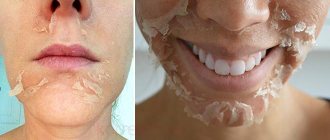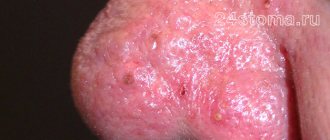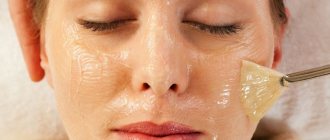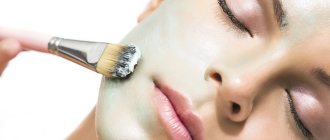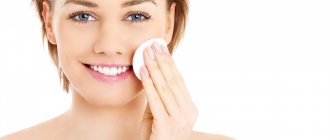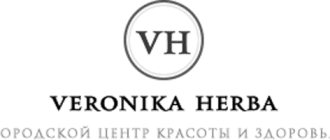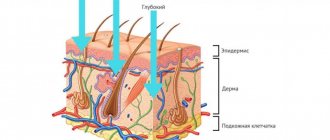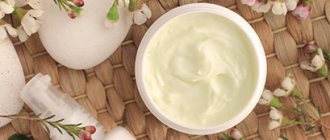Main principles of skin care after chemical peeling
Regardless of the type of peeling used and the degree of its penetration into the layers of the skin, there are a number of requirements that must be strictly observed during the recovery period.
Under no circumstances should you touch your face on the first day . This means that any procedures related to washing, applying moisturizers, etc. are prohibited. The only exceptions are special instructions from a cosmetologist regarding the specifics of the procedure itself. For example, with retinoic or yellow peeling, you will need to remove the product from your face yourself in strict accordance with the recommendations received. It is undesirable to touch your face in the following days, since injured skin is very susceptible to the action of bacteria that can cause serious inflammatory processes.
You can only wash your face the next day with clean boiled water . The cleansers used should be mild and should be applied to the face carefully, using your fingertips. During the recovery period - and after chemical peeling, it can take up to 2 months - you should avoid using scrubs, which will further injure the epidermis and can lead to scarring.
To alleviate the condition, as well as to prevent the skin from cracking and cracking whenever severe tightness appears, it is recommended to use moisturizing gels or foams that are easy to apply and absorb well. It is better not to use creams at first - their time will come when the skin begins to peel off. In this case, it is advisable to select products with moisturizing, antioxidant, anti-inflammatory, regenerating properties - the composition will include selenium, omega acids, Shea butter, hyaluronic acid, retinol, etc.
An excellent product for moisturizing the skin and accelerating the regeneration process is Panthenol spray - it is advisable to purchase it in advance and always have it on hand. Panthenol is generously applied to the facial skin several times a day (3-4 after superficial peeling and 7-8 after medium peeling) until the skin is completely restored. Excess Panthenol should be easily removed with a clean cloth after a quarter of an hour. Despite all the advantages of Panthenol, it must be used in accordance with the recommendations: after superficial chemical peeling - a day later, after medium peeling - no earlier than 3-4 days (by this time a strongly constricting film will appear on the face, with a color ranging from normal to brown).
No one denies the positive effects of various soothing masks made from natural ingredients on irritated skin, but it is better not to resort to them on your own during the post-peeling period. Here you need a preliminary consultation with a cosmetologist, since even the most familiar product can become a strong allergen and cause irritation.
Summary
Post-peeling peeling is a typical and constant phenomenon that accompanies almost every exfoliation session. This process indicates the launch of skin renewal processes and the elimination of dead layers of the epidermis. The intensity of exfoliation depends on many factors: the type of peeling, the characteristics of the skin and the woman’s body. In addition, the skill of the cosmetologist and the absence of possible contraindications play an important role.
The duration of peeling depends on proper skin care. Usually the process does not last longer than 1 or 2 weeks. In cases where the skin does not return to normal for a long time, it is necessary to consult a cosmetologist.
Note!
- If a film appears on the face after medial peeling, it is better to eat pureed, soft food in order to strain the facial muscles less.
- It is forbidden to remove flaky layers of skin or formed crusts - this is one of the reasons for the appearance of scars after peeling. The skin should cleanse itself of dead cells, even if it takes a long time - a week or more (it all depends on the type of peeling and the degree of its effect on the epidermis). Washing and applying moisturizer is all you can do to help your skin during this period.
- During the period of skin restoration, you cannot use decorative cosmetics; in extreme cases, only light tinting of the eyes and lips is allowed. You can switch to your usual facial care products when the skin gets rid of the primary effects of peeling: redness, swelling, peeling.
- It is advisable to plan the medial peeling so that 3-4 days after it can be done at home and not go outside in order to avoid any environmental exposure.
- In the first 3 months after chemical peeling, it is strictly forbidden to visit a bathhouse, solarium, sauna, or go outside without a cream that reliably protects against sun rays (with an SPF effect of 30 or more). The same applies to trips to hot countries. The consequences of violating these requirements can be quite disastrous - scars or age spots will appear on skin that has not completely healed, and serious inflammatory processes will begin in the layers of the dermis, which can be very difficult, and sometimes impossible, to get rid of. That is why all peelings are recommended to be carried out during periods of low sun activity - in autumn and winter.
Ingestion of vitamins has a positive effect on the regeneration process and the elimination of possible inflammation. By the way, vitamins A and C will enhance the effect of whitening products, if they are prescribed by a specialist.
In case of unusual situations, for example, with a strong and persistent burning sensation, persistent redness, signs of allergies - this can be caused by both the peeling itself and the products used during the recovery period for skin care - you should immediately contact your doctor and get recommendations for further actions. Sometimes it may be necessary to prescribe a whole range of drugs and special procedures that will help avoid possible complications.
Thus, the result of chemical peeling largely depends not only on the skill of the cosmetologist, but also on your efforts. A little patience - and as a reward you will receive a refreshed and rejuvenated face.
Find out the cost of the Chemical Peeling procedure
Why does the skin peel?
Peeling after peeling is a common process that is considered typical after the use of exfoliants. To understand why such changes occur in the face, you need to understand what the exfoliation procedure is.
Peeling is designed to remove the upper, keratinized layers of the epidermis. It is this part of the integument that causes uneven complexion.
In salons, clients are offered the following types of cleaning:
- superficial;
- median;
- deep.
It depends on the type of cleansing on what day the facial skin will begin to peel and how intense the exfoliation will be after peeling.
The results of the peeling are:
- Elimination of wrinkles due to exfoliation of the upper layers of the epidermis.
- Lightening of age spots and freckles under the influence of acids.
- Reduction or complete elimination of post-acne, scars and scars.
- Improving complexion, smoothing its surface.
- Increasing skin elasticity, tightening the oval contour of the face.
To achieve these results, it is necessary to get rid of dead cells of the surface layer of the epidermis that have fulfilled their function. This effect is achieved due to active peeling of the skin - the peeled “shreds” are those very outdated integuments.
That is why you should not be afraid of peeling; on the contrary, you should expect it, since it is a natural and inevitable process. Peeling is an indicator of the effectiveness of the exfoliant, a sign that the master did his work efficiently and conscientiously.
What procedures require a recovery period?
A recovery period is required after the following procedures:
- microneedling;
- microdermabrasion;
- chemical peels;
- hardware procedures;
- invasive procedures;
- surgical procedures.
All of them, in one way or another, provoke injury to the skin in order to remove the stratum corneum of cells, launch natural mechanisms of regeneration, production of collagen and elastin. The flip side of effectiveness is the unpleasant reactions of our skin.
The difference between glycolic peeling and other peelings
Unlike peeling with trichloroacetic acid or phenol, glycolic peeling has a very gentle effect on the skin without causing any harm to it. That is why it is incredibly popular among beauty salon patients. This method of rejuvenation allows it to be used as a cosmetic procedure, because it does not cause prolonged redness of the skin and a strong inflammatory reaction. Immediately after the session, patients can use cosmetics and not limit themselves to going out, which cannot be said about other types of peeling. You will be able to demonstrate to others your clean, radiant and rejuvenated skin on the same day.
The glycolic peeling procedure is called differently: acid peeling, AHA peeling, glycolic or fruit acid peeling. For the session, glycolic acid of different concentrations is used - usually from 35% to 70%, where 70% concentration is the maximum permissible level of use.
Advantages and features of glycolic peeling
Glycolic peeling has established itself as the safest and most painless method of skin rejuvenation. Thanks to the special components included in the peeling solution, even a 70% concentration of glycolic acid is completely safe for the skin. They are responsible for the penetration of active substances into the skin to the required depth. Ingredients developed using the latest technologies today make it possible to perform active glycolic peeling, because they block the patient’s perception of sensitive receptors. Therefore, during the session the patient feels quite comfortable: he does not feel itching, irritation or swelling, but only a slight tingling of the skin.
Indications for glycolic peeling
- mesh of wrinkles;
- unhealthy complexion;
- age spots and hyperpigmentation;
- small scars caused by acne;
- stretch marks;
- rosacea;
- preparation for laser treatment of the skin or plastic surgery;
- thickening of the stratum corneum;
- rehabilitation period after aggressive procedures;
- thin dry skin that needs elastin and collagen;
- too oily facial skin;
- uneven skin texture;
- slow blood circulation.
By the way, peeling with glycolic acid can be used to renew the epidermis of the skin without any indication.
The positive effect of glycolic acid is observed due to its penetration deep into the skin, thereby eliminating comedones (plugs) and opening pores, smoothing the surface of the skin and pushing it to produce its own elastin and collagen. Thanks to this, wrinkles are pushed out, skin pores are tightened and it is renewed.
Today there are two types of glycolic peeling: light and medium, which differ from each other in the concentration of acid in the preparation.
Light peeling with glycolic acid is most often used as a preventive measure to normalize the fat balance in patients with oily skin, as well as against clogged pores. This procedure can be carried out once a month.
Medium peeling in its effect on the skin is very close to other, more aggressive cosmetic procedures. This peeling is recommended to be performed in a course of 3-5 sessions once a week. After the procedure, slight redness remains on the skin for 1-2 hours. The patient will be able to see a noticeable improvement in the condition of their skin within 3-5 days after the procedure.
How to speed up the peeling process?
Sagging crusts and a white, cracked mesh of “dead” skin on the face do not make even the most beautiful ladies attractive. To activate the peeling process and quickly get your skin in order, you can use the following tips:
- Peeling will be significantly accelerated if you use moisturizing and regenerating preparations with antioxidants, hyaluronic acid, glycerin, urea, vitamins and nicotinic acid;
- If peeling is accompanied by intense itching, use pharmaceutical preparations with a calming and healing effect, which contain panthenol and bisabolol. Boro Plus cream has a good effect;
- In case of a pronounced inflammatory process, it is possible to use stronger pharmaceutical agents, such as Levomekol ointment and hydrocortisone cream. Remember that medications containing hydrocortisone should only be used as prescribed by a doctor.
Helpful advice: if you are concerned about severe persistent peeling, ask your cosmetologist if you can undergo an additional peeling procedure using enzymes or lactic acid. In some situations, such a measure is considered acceptable to facilitate the exfoliation process.
Severe peeling is a typical reaction to chemical peeling. Exfoliation and the accompanying increased separation of dead particles of the stratum corneum of the skin indicate that the process of renewal of the epidermis and dermis has begun.
The intensity of peeling is determined by many factors, among which the professionalism of the cosmetologist is not the least condition. As a rule, the duration of the peeling process takes about 10 - 15 days , but if you feel that there is no improvement, you should consult a cosmetologist or dermatologist.
When preparing the material, consultation was carried out by:
Ekaterina Smirnova (dermatologist). Certified specialist with 20 years of experience. He is engaged in the diagnosis and treatment of dermatological diseases, and removes tumors. Proficient in injection cosmetology techniques for the face and body.
Share with your friends!
more
Read us in the Zen channel
